Pre-Cooling Concrete System in Massive Concrete Production: Energy Analysis and Refrigerant Replacement
Abstract
1. Introduction
2. Apparatus and Experimental Work
2.1. Description of the Pre-Cooling Concrete Mixture Systems
2.2. Experimental Work
3. Numerical and Experimental Analysis and Discussion
3.1. Physical and Chemical Properties of Refrigerates
3.2. Simulation and Validation of the Numerical Work
3.3. Results and Discussion
4. Conclusions
Author Contributions
Funding
Institutional Review Board Statement
Informed Consent Statement
Data Availability Statement
Conflicts of Interest
Nomenclature
| Variable | Definition | Units |
| EES | Engineering Equation Solver | |
| The coefficient of performance | ||
| Enthalpy | ||
| Enthalpy at the outlet of the evaporator | ||
| Enthalpy at the inlet of the evaporator | ||
| Enthalpy at the inlet of the compressors, see Figure 2 | ||
| Enthalpy at the out of the compressors, see Figure 2 | ||
| Mass flow rate of Refrigerant | kg s−1 | |
| Cooling coil capacity of single evaporator | ||
| Net cooling capacity of evaporators | ||
| Standard error of the mean | ||
| Standard deviation | ||
| Drive power in compressors |
Appendix A. General Assessment of Different Types of Refrigerants
| Characteristic | Criteria | Evaluation (1: Best; 3: Worst) | Explanation | ||
| R22 | R32 | R410a | |||
| Critical Temperature | It should be above the condensing temperature | 1 | 2 | 3 | To achieve a high heat transfer at a constant temperature to reduce power consumption by the refrigeration system |
| Critical Pressure | It should be positive and moderate | All refrigerants achieve the criteria | In case of high pressure, the refrigeration system will be a heavy and bulky. In case of low pressure, the increase possibility of air leakage into the system. | ||
| Enthalpy of Vaporization | It should be large as possible | 3 | 1 | 2 | To reduce the mass flow rate per ton of refrigeration. To reduce the area under the curve for superheat and the area reduction due to the throttling process. |
| Conductivity | It should be high as possible | 3 | 2 | 1 | To control of a size of the condenser and evaporator without any difficulties |
| Specific Heat for the liquid | It should be small as possible | 1 | 3 | 2 | To minimize the irreversibilities corresponding to throttle process, which leads to increase the liquid subcool. |
| Specific Heat for the vapor | It should be high as possible | 3 | 1 | 2 | To be less superheating of the vapor. |
| Evaporator and Condenser Pressure | It should be above atmospheric pressure | All refrigerants achieve the criteria | To prevent the air leakage into refrigeration system which reduce the refrigeration system capacity and the moisture air leads to corrosive tubing of the refrigeration system. | ||
| Compression Ratio | It should be small as possible | NO evaluation | To prevent the refrigerant leakage occurs around the piston, Moreover, it is a crucial parameter for volumetric efficiency | ||
| Freezing Point | It should be small as possible | 1 | 3 | 2 | To prevent the a possibility of occurring blockage due to very low temperature in evaporator |
| Density | It should be high as possible | For Liquid | Effects on the size of a compressor, which A high value of density leads in high pressure rise | ||
| 1 | 3 | 2 | |||
| For Vapor | |||||
| 3 | 2 | 1 | |||
| Compression Temperature | It should have a low compression temperature | 3 | 2 | 1 | Increases the wall cylinder temperature after compression process, this requires an external cooling for cylinder walls to prevent material and volumetric losses. |
| Flammability | It must be non-flammable. | None | A2L * | None | To avoid a fire when subjected to high temperatures |
| Miscibility with Oil | It should not be miscible with the oil | 3 | 2 | 1 | To prevent loss of lubricating strength |
| Toxicity | It should not be toxic | None | None | toxicity | It may be come into contact with human beings |
| Viscosity | It should be as small as possible | For Liquid | To keep the system pressure drop is small. The less viscosity, the less energy required for its Circulation | ||
| 3 | Same | ||||
| For Vapor | |||||
| 2 | 1 | 2 | |||
| * A2L is non-toxic and mildly flammable refrigerants. | |||||
References
- Riding, K.A.; Poole, J.L.; Schindler, A.K.; Juenger, M.C.; Folliard, K.J. Evaluation of temperature prediction methods for mass concrete members. ACI Mater. J. 2006, 103, 357–365. [Google Scholar]
- Kjellsen, K.O.; Detwiler, R.J.; Gjørv, O.E. Development of microstructures in plain cement pastes hydrated at different temperatures. Cem. Concr. Res. 1991, 21, 179–189. [Google Scholar] [CrossRef]
- Portland Cement Association, Portland Cement, Concrete, and Heat of Hydration. 1997, Volume 18, pp. 1–8. Available online: http://readymixmuscat.com/wp-content/uploads/2016/10/pl972.pdf (accessed on 30 January 2022).
- Branco, F.A.; Mendes, P.; Mirambell, E. Heat of hydration effects in concrete structures. Mater. J. 1992, 89, 139–145. [Google Scholar]
- ACI 207.4R-05; Cooling and Insulating System for Mass Concrete. American Concrete Institute (ACI): Farmington Hills, MI, USA, 2005.
- Ishee, C.; Surana, S. Hot weather concreting. In Developments in the Formulation and Reinforcement of Concrete, 2nd ed.; Chapter 6; Woodhead Publishing: Cambridge, MA, USA, 2019; pp. 131–150. [Google Scholar] [CrossRef]
- Stewart, M.G.; Mullard, J.A. Spatial time-dependent reliability analysis of corrosion damage and the timing of first repair for RC structures. Eng. Struct. 2007, 29, 1457–1464. [Google Scholar] [CrossRef]
- Yunovivh, M.; Thompson, N.G.; Balvanyos, T.; Lave, L. Corrosion Costs and Preventative Strategies in the United States; Report FHWARD-01-156; Highway Administration (FHWA), Office of Infrastructure Research and Development: Washington, DC, USA, 2002. [Google Scholar]
- Abdel-Raheem, M.; Quintana, O.; Morales, M.; Marroquin-Villa, Y.; Ramos, D.; Hernandez, S. Construction methods used for controlling temperature in mass concrete structure. In Creative Construction Conference 2018, Proceedings of the Creative Construction Conference, Ljubljana, Slovenia, 30 June–3 July 2018; Budapest University of Technology and Economics: Budapest, Hungary, 2018; pp. 139–146. [Google Scholar] [CrossRef]
- Abendeh, R.M.; Bani Baker, M. Using steel slag aggregate to strengthen self-compacting concrete durability. Proc. Inst. Civ. Eng. Struct. Build. 2021, 174, pp. 1–15. [Google Scholar] [CrossRef]
- Madi, M.; Refaat, N.; Negm El Din, A.; Ziada, F.; Mazen, M.; Ahmed, S.; Hamza, A.S.; El Nahas, E.; Fathy, A.; Fahmy, E.H. The impact of mixing water temperature on portland cement concrete quality. In Proceedings of the CSCE Annual Conference, Vancouver, BC, Canada, 31 May–3 June 2017. [Google Scholar]
- Alamayreh, M.I.; Barham, T.; Shaban, N.A.; Olimat, A.N. Design of High Efficiency Aggregate Air Cooling System. In Proceedings of the Second Thermal and Fluids Engineering Conference, Las Vegas, NV, USA, 2–5 April 2017; pp. 2369–2375. [Google Scholar] [CrossRef]
- ACI 207.1R-05; Guide to Mass Concrete. American Concrete Institute (ACI), ACI Committee 207: Farmington Hills, MI, USA, 2005.
- International Commission on Large Dams (ICOLD). Conventional Methods in Dam Construction: Review; Commission Internationale des Grands Barrages: Paris, France, 1990. [Google Scholar]
- 305R-10; Guide to Hot Weather Concreting. American Concrete Institute (ACI), ACI Committee 305: Farmington Hills, MI, USA.
- Nakane, S.; Saito, H.; Ohike, T. Strength development and microstructure of cement and concrete precooled with liquid nitrogen. In Proceedings of the International Conference on Concrete in Hot Climates, Concrete in Hot Climates, Torquay, UK, 21–25 September 1992. [Google Scholar]
- Harith, I.K.; Hassan, M.S.; Hasan, S.S. Liquid nitrogen effect on the fresh concrete properties in hot weathering concrete. Innov. Infrastruct. Solut. 2022, 7, 127. [Google Scholar] [CrossRef]
- John, G.; Kaufman, A.; Sumodjo, F. Precooling Mass Concrete, Concrete Construction. 2005, 8. pp. 36–40. Available online: https://www.concreteconstruction.net/how-to/materials/precooling-mass-concrete_o (accessed on 21 December 2021).
- Basham, K. How to Plan and Manage Curing for Mass Concrete Pours. 29 July 2014. Available online: www.forconstructionpros.com/concrete/equipmentproducts/article/11598829/how-to-plan-and-manage-curing-for-mass-concrete-pours (accessed on 29 January 2022).
- Bamforth, P.B. Early-Age Thermal Crack Control in Concrete; CIRIA Report C660; Construction, Built Environment, Civil Engineering: London, UK, 2007. [Google Scholar]
- Wang, Y.; Liu, F.; Xu, L.; Zhao, H. Effect of elevated temperatures and cooling methods on strength of concrete made with coarse and fine recycled concrete aggregates. Constr. Build. Mater. 2019, 210, 540–547. [Google Scholar] [CrossRef]
- Tasri, A.; Susilawati, A. Effect of cooling water temperature and space between cooling pipes of post-cooling system on temperature and thermal stress in mass concrete. J. Build. Eng. 2019, 24, 100731. [Google Scholar] [CrossRef]
- Ben Jemaa, R.; Mansouri, R.; Boukholda, I.; Bellagi, A. Energy and exergy investigation of R1234ze as R134a replacement in vapor compression chillers. Int. J. Hydrogen Energy 2017, 42, 12877–12887. [Google Scholar] [CrossRef]
- Alahmer, A.; Wang, X.; Al-Rbaihat, R.; Alam, K.C.A.; Saha, B.B. Performance evaluation of a solar adsorption chiller under different climatic conditions. Appl. Energy 2016, 175, 293–304. [Google Scholar] [CrossRef]
- Alahmer, A.; Ajib, S. Solar cooling technologies: State of art and perspectives. Energy Convers. Manag. 2020, 214, 112896. [Google Scholar] [CrossRef]
- Alahmer, A.; Alsaqoor, S. Energy efficient of Using Chilled Water System for Sustainable Health Care Facility Operating by Solar Photovoltaic Technology. Energy Procedia 2019, 156, 65–71. [Google Scholar] [CrossRef]
- Alahmer, A.; Alsaqoor, S. Simulation and optimization of multi-split variable refrigerant flow systems. Ain Shams Eng. J. 2018, 9, 1705–1715. [Google Scholar] [CrossRef]
- Alabdulkarem, A.; Eldeeb, R.; Hwang, Y.; Aute, V.; Radermacher, R. Testing, simulation and soft-optimization of R410A low-GWP alternatives in heat pump system. Int. J. Refrig. 2015, 60, 106–117. [Google Scholar] [CrossRef]
- Vali, S.S.; Setty, T.P.; Babu, A. Analytical computation of thermodynamic performance parameters of actual vapour compression refrigeration system with R22, R32, R134a, R152a, R290 and R1270. MATEC Web Conf. EDP Sci. 2018, 144, 4009. [Google Scholar] [CrossRef][Green Version]
- Xu, X.; Hwang, Y.; Radermacher, R. Performance comparison of R410A and R32 in vapor injection cycles. Int. J. Refrig. 2013, 36, 892–903. [Google Scholar] [CrossRef]
- Tu, X.; Liang, X.; Zhuang, R. Study of R32 refrigerant for residential air-conditioning applications. In Proceedings of the 23rd International Congress of Refrigeration, Prague, Czech Republic, 21–26 August 2011; p. 259. [Google Scholar]
- Panato, V.H.; Pico, D.F.; Bandarra Filho, E.P. Experimental evaluation of R32, R452B and R454B as alternative refrigerants for R410A in a refrigeration system. Int. J. Refrig. 2021, in press. [Google Scholar] [CrossRef]
- Ahamed, J.U.; Saidur, R.; Masjuki, H.H. A review on exergy analysis of vapor compression refrigeration system. Renew. Sust. Energ. Rev. 2011, 15, 1593–1600. [Google Scholar] [CrossRef]
- Fajar, T.B.; Bagas, P.R.; Ukhi, S.; Alhamid, M.I.; Lubis, A. Energy and exergy analysis of an R410A small vapor compression system retrofitted with R290. Case Stud. Therm. Eng. 2020, 21, 100671. [Google Scholar] [CrossRef]
- Al-Dabbasa, M.; Alahmer, A.; Mamkaghd, A.; Gomaae, M.R. Productivity enhancement of the solar still by using water cooled finned condensing pipe. Desalination Water Treat. 2021, 213, 35–43. [Google Scholar] [CrossRef]
- Alahmer, A.; Al-Dabbas, M.; Alsaqoor, S.; Al-Sarayreh, A. Utilizing of solar energy for extracting freshwater from atmospheric air, Appl. Sol. Energy 2018, 54, 110–118. [Google Scholar] [CrossRef]
- Chen, J.; Yu, J. Performance of a new refrigeration cycle using refrigerant mixture R32/R134a for residential air-conditioner applications. Energy Build. 2008, 40, 2022–2027. [Google Scholar] [CrossRef]
- Cheng, S.; Wang, S.; Liu, Z. Cycle performance of alternative refrigerants for domestic air-conditioning system based on a small finned tube heat exchanger. Appl. Therm. Eng. 2014, 64, 83–92. [Google Scholar] [CrossRef]
- Tian, Q.; Cai, D.; Ren, L.; Tang, W.; Xie, Y.; He, G.; Liu, F. An experimental investigation of refrigerant mixture R32/R290 as drop-in replacement for HFC410A in household air conditioners. Int. J. Refrig. 2015, 57, 216–228. [Google Scholar] [CrossRef]
- Bolaji, B.O. Experimental study of R152a and R32 to replace R134a in a domestic refrigerator. Energy 2010, 35, 3793–3798. [Google Scholar] [CrossRef]
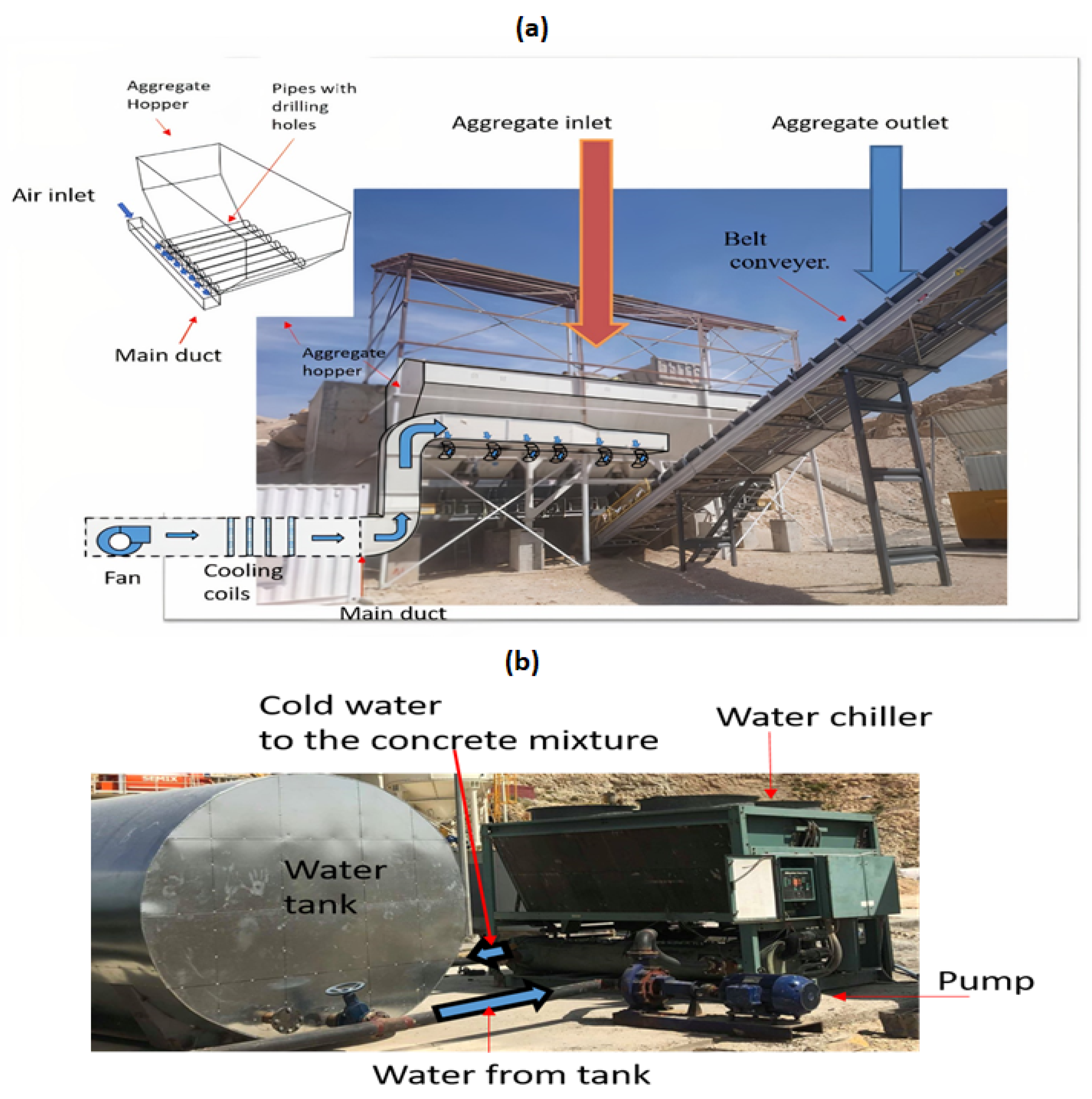
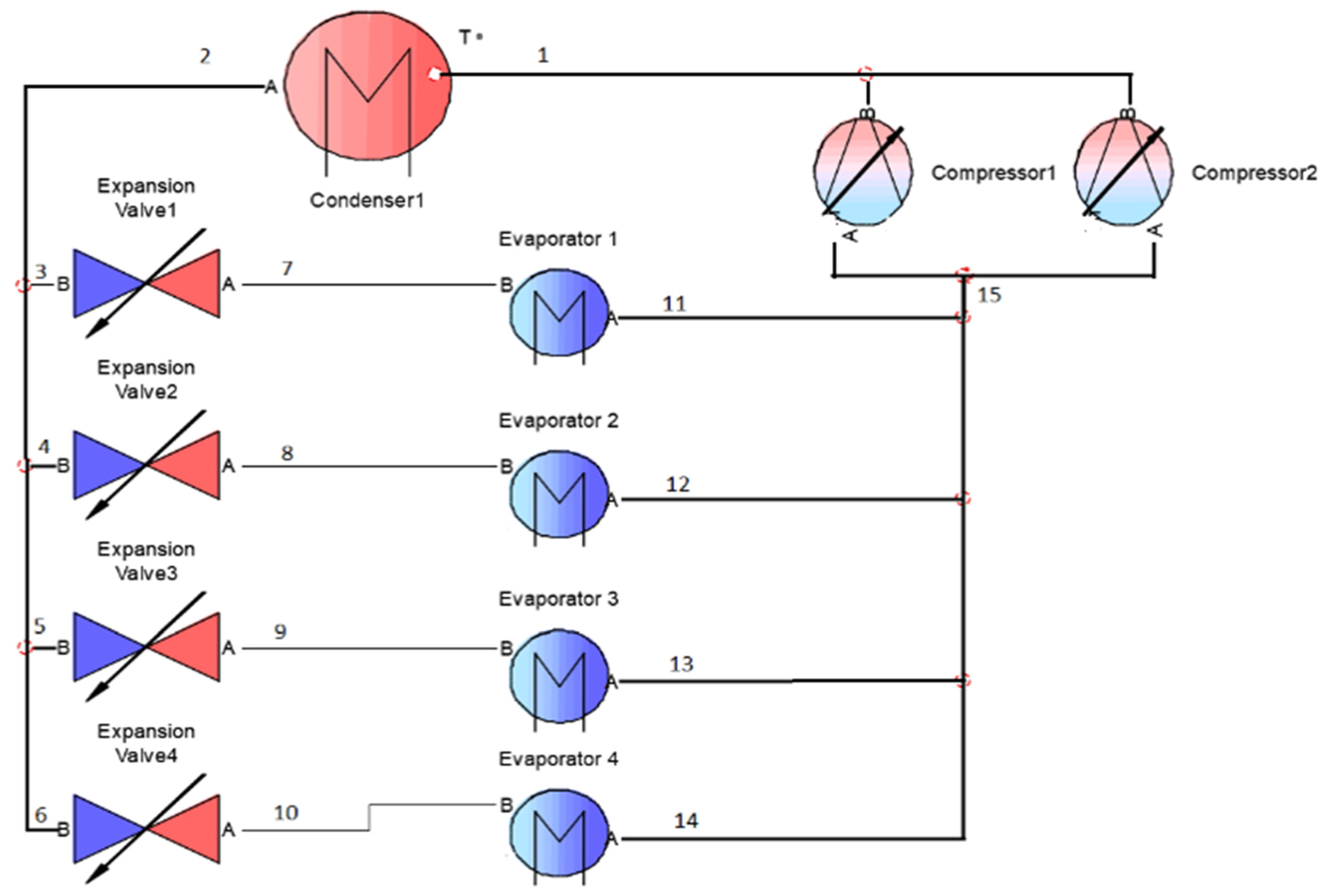
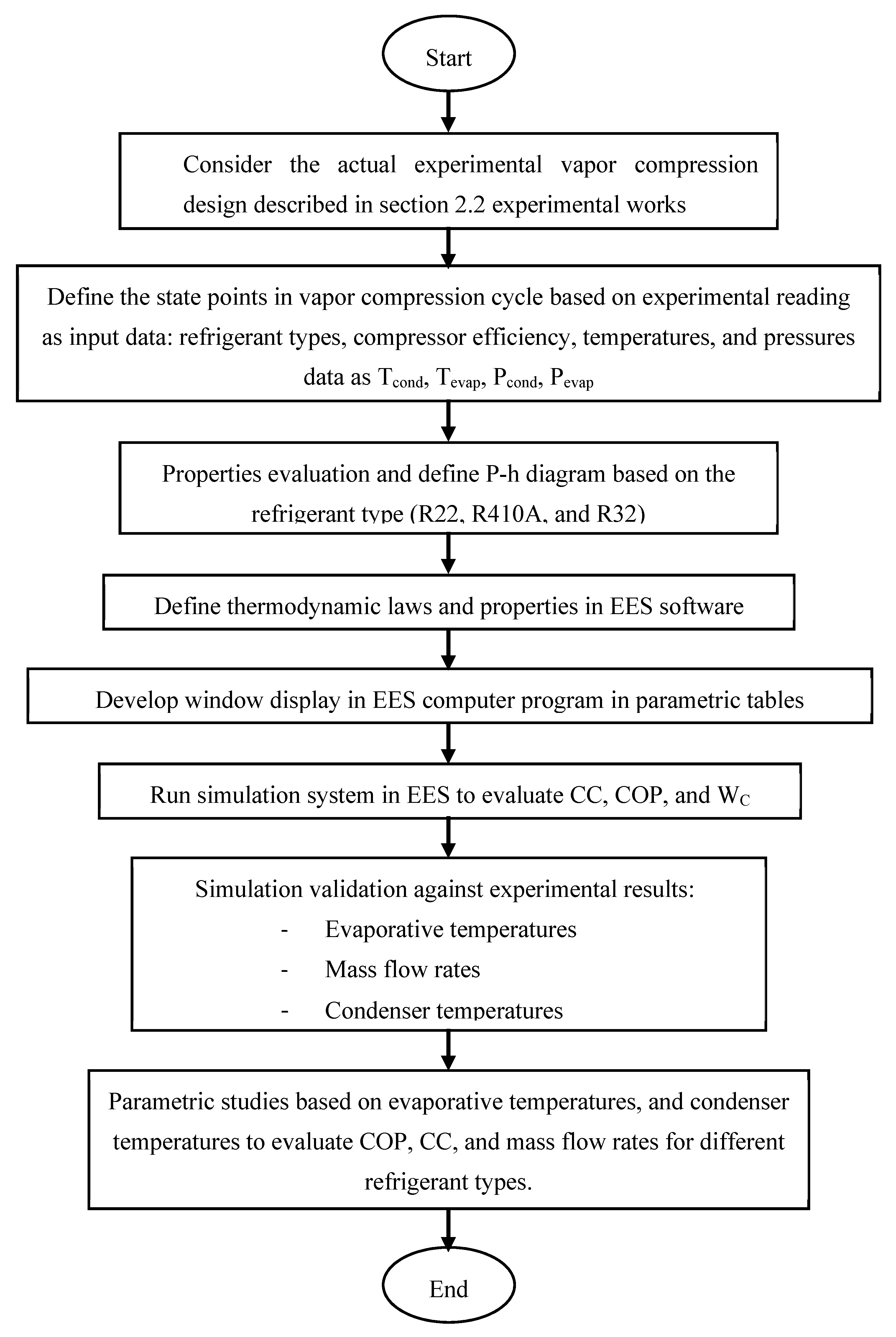
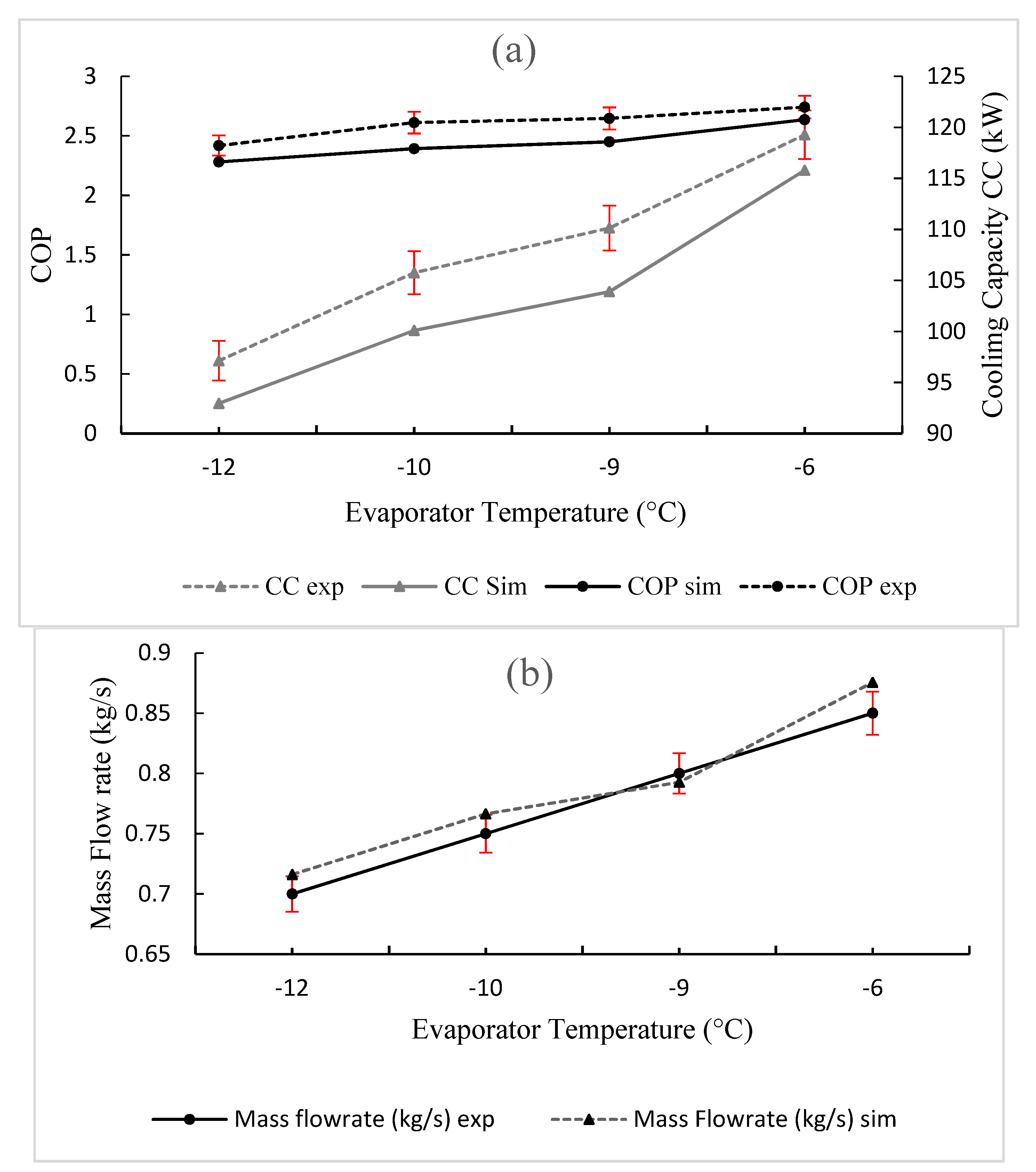
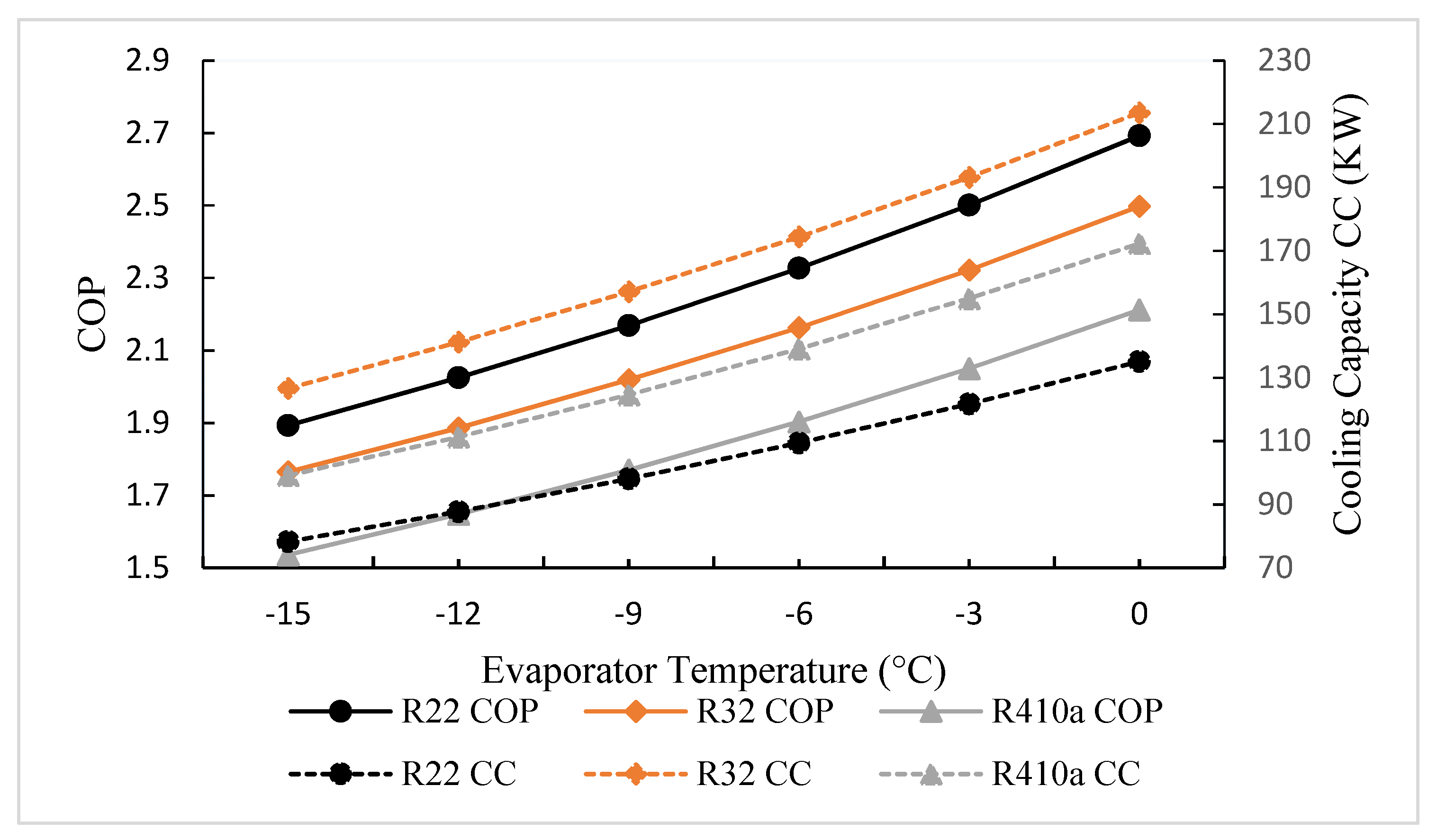
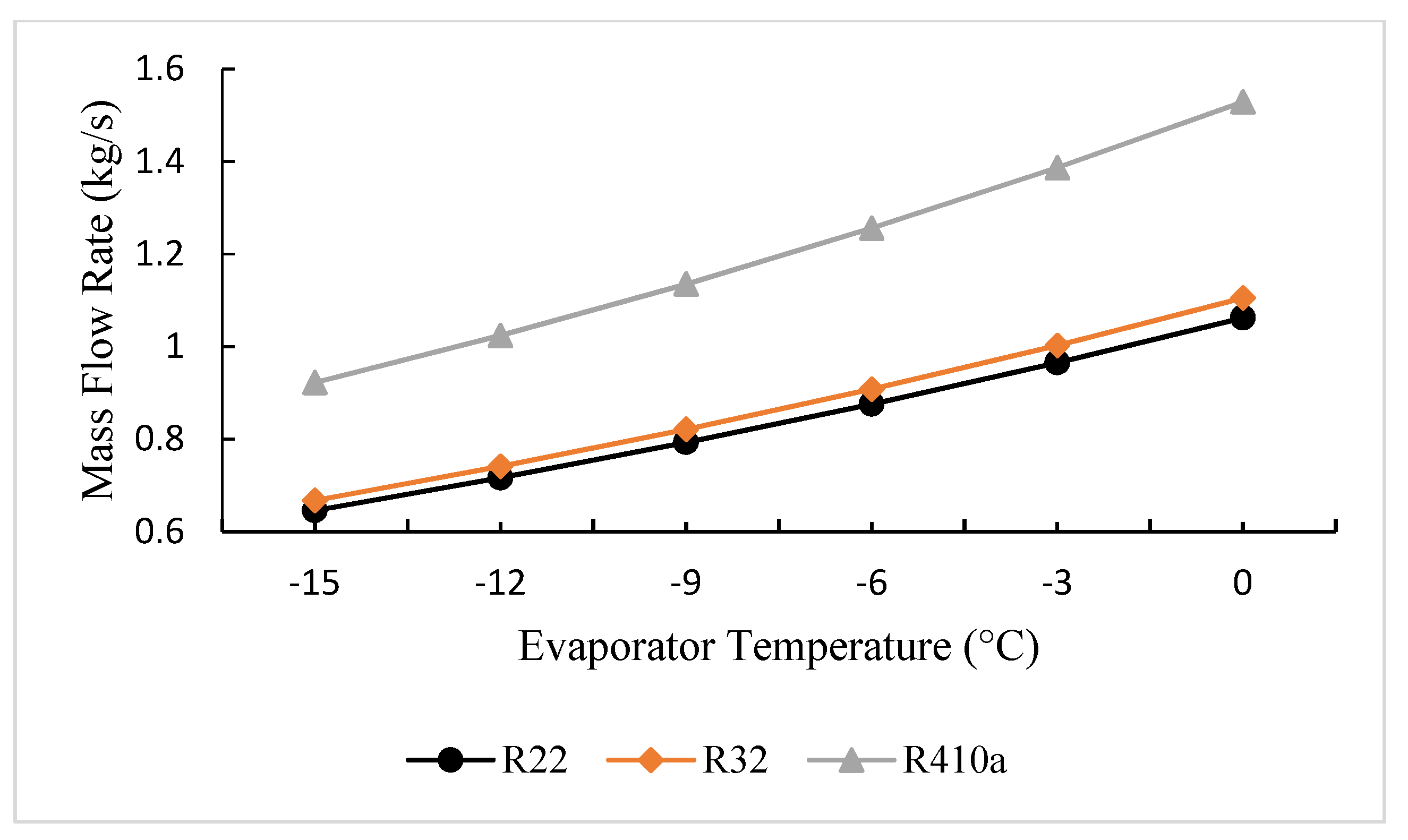
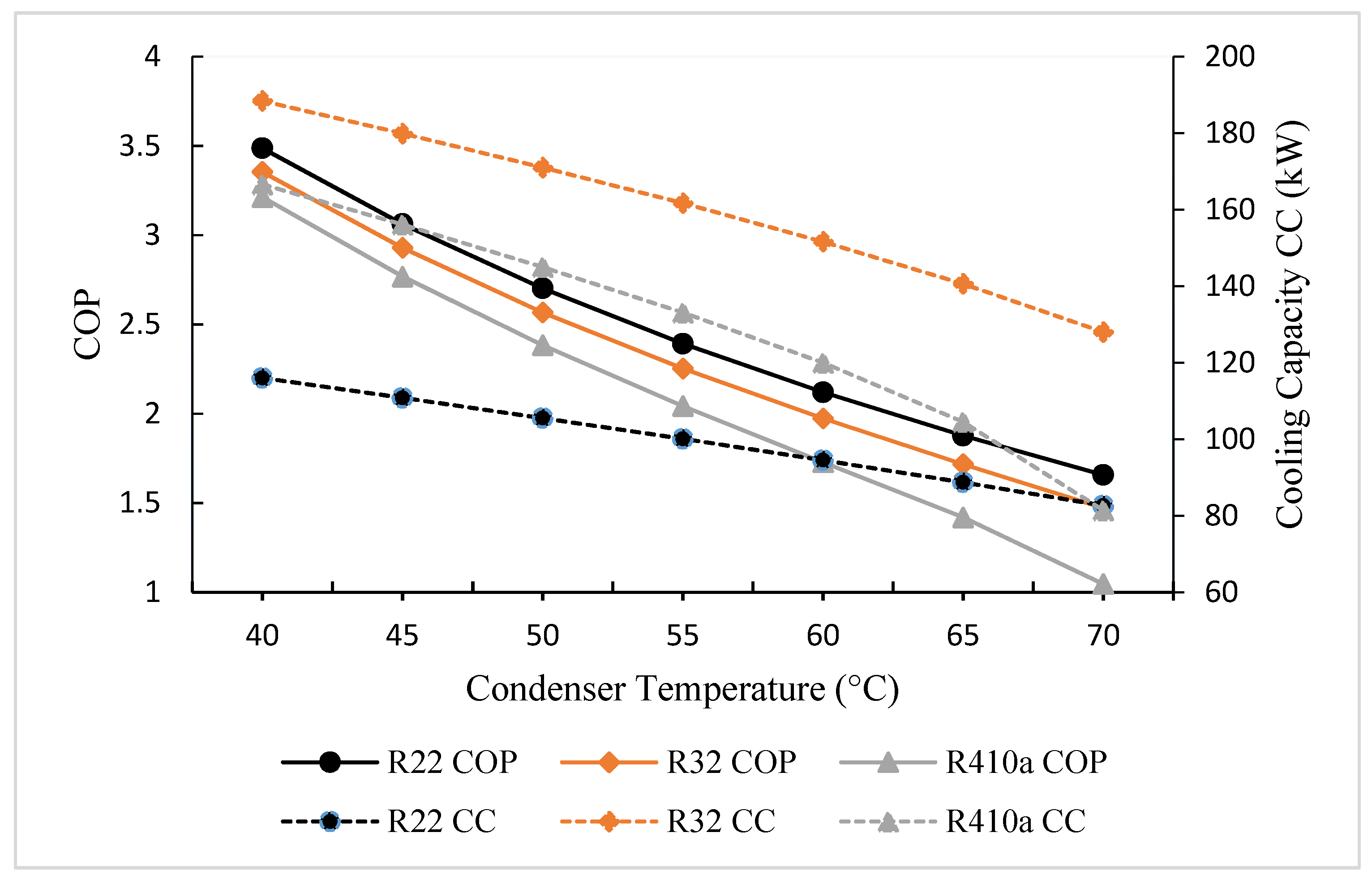
| Component | No. Units | Properties | Initial Investment per Unit or m | Initial Investment (USD) |
|---|---|---|---|---|
| Duct | 7 | Insulated ducts | 56 | 392 |
| Compressors | 2 | Semi hermetic compressor Copeland, model D8DJ-600/-600x, full load capacity is 74 , the suction and discharge diameter are 3.1/8 (9.843 mm) and 1.5/8 (4.76 mm), respectively. | 11,284 | 22,568 |
| Evaporators | 4 | Fins and tube Karyer Evaporator, Model: 4,501,421 heat capacity 75 . Each has heat transfer area 151 Inlet diameter 42 and outlet diameter 28 mm and the evaporators are connected in parallel. | 2540 | 10,160 |
| Fan | 1 | Centrifugal fan Model RDY-1000 NICORTA input power 40 can increase the pressure up to 2200 Pa. Number of blades 11, impeller diameter 1002 and impeller weight 146 | 6350 | 6350 |
| Refrigerant | 135 L | Refrigerant R22 | 7.31 | 987 |
| Control and safety | 1 3 | Control unit Contactor 63 | 282 141 | 282 423 |
| Pipes Cupper | 80 | 24 | 1920 | |
| Expansion valve | 4 | Thermostatic expansion valve Model: XC-726HW352B suitable for the evaporator heat capacity, Maximum operating pressure limit 35 psi (241 kPa). | 10 | 40 |
| Condenser | 1 | Karyer Fins and tube condenser has a heat transfer capacity 450 kW | 9168 | 9168 |
| Oil separator | 1 | 100 | 1834 | 1834 |
| Tank gas | 1 | 150 | 2540 | 2540 |
| Filter | 3 | Basic filter for particles size matter have a size ranging from 2.5 to 10 and more | 4.23 | 13 |
| Sight glass | 7 | Indicate too high moisture content and refrigerant deficiency, Working pressure up to 3500 . | 8.5 | 60 |
| Container | 1 | 2820 | 2820 | |
| Aggregate hopper | 1 | Dimensions 5600 × 1560 × 2760 | 4230 USD/unit | 4230 |
| Total | 63,787 USD | |||
| Component | No. Units | Properties | Initial Investment per Unit or m | Initial Investment USD |
|---|---|---|---|---|
| Chiller | 1 | Water chiller Brand: YORK model YCAZ74BB3 65.1 nominal tons Two refrigeration circuits 55 HP (40.45 kW) reciprocating hermetic Compressor Condenser with two fans Water volume max 250 () Refrigerant R-22 | 98,732 USD/unit | 40,904 |
| Water tank | 4 | Volume of stainless steel tank is 10 m3 | 2820 | 11,280 |
| Centrifugal pump | 1 | Horizontal centrifugal pump Volume flow 0–1870 , Pressure range 0–16 Speed range 700–3500 Drive rating 0.37 kW–100 | JD | 2820 |
| Pipes and valves | 1834 USD | 2116 | ||
| Total | 57,120 | |||
| R22 | R32 | R410a | |
|---|---|---|---|
| Formula | CHClF2 | Ch2F2 | Ch2F2 (50%) + CHF2CF3 (50%) 50% R32 + 50%R125 |
| Group | Halocarbon (HCFC) | HFO | Zeotropic mixture |
| Molecular Weight [kg/kmol] | 86.47 | 52.024 | 72.59 |
| Critical Temperature [°C] | 96.15 | 78.11 | 71.35 |
| Critical Pressure [kPa] | 4990 | 5782 | 4902 |
| Critical Density [kg/m3] | 523.84 | 424.00 | 459.53 |
| Boiling point at 1 ATM [°C] | −40.8 | −51.65 | −51.5 |
| Latent Heat of Vaporization at 25 °C [kJ/kg] | 182.74 | 270.910 | 190.6 |
| Specific heat of liquid (25 °C) [kJ/kg.k] | 1.257 | 1.94 | 1.69 |
| Specific heat of vapor (101.3 kPa) [kJ/kg.k] | 0.662 | 0.848 | 0.822 |
| Specific heat ratio (25 °C, 101.325 kPa) | 1.185 | 1.252 | 1.175 |
| Thermal conductivity (25 °C, saturated gas) [mW/(m·K)] | 11.4 | 12.4 | 15.5 |
| Freezing Point [°C] | −160 | −136 | −155 |
| Density (25 °C, saturated liquid) [kg/m3] | 1191 | 958.8 | 1061 |
| Density (25 °C, saturated gas) [kg/m3] | 44.2 | 47.339 | 65.6 |
| Viscosity (25 °C, saturated liquid) [μPa·s] | 165.8 | 121 | 120.9 |
| Viscosity (25 °C, saturated gas) [μPa·s] | 12.7 | 12.3 | 13.9 |
| Solubility in water (25 °C, 101.325 kPa) [%] | 0.3 | 0.21 | Negligible |
| Ozone Depletion Potential (ODP) | 0.055 | 0 | 0 |
| Global Warming Potential (GWP) | 1810 | 675 | 1725 |
| Flammable | A1 None | A2L Mildly Flammable Lower flammability limit (% vol.): 12.7 Upper flammability limit (% vol.): 33.4 | A1 None |
| Toxicity | Non-toxic | Non-toxic | Allowance exposure limit (AEL): 1000 ppm very low toxicity |
| Sensors | Properties | Usage |
|---|---|---|
| T-type thermocouples (copper/constantan) | Low temperature within a range between −200 °C to 200 °C and it has uncertainty ±0.15 °C. | Measuring the temperatures of refrigerant |
| Infrared thermometer model Testo 830 | Operating temperature between −20 to +50 °C with accuracy ±2 °C or ±2% of and has 0.1 °C resolution. | Measuring the temperature of aggregate |
| Fluid gauge pressure | 1% accuracy and can measure up to 500 psi (3447.4 kPa) | The refrigerant gauge pressure |
| Volumetric flow meter | Measurement field 0–6 and ±0.2% uncertainty | The refrigerant volumetric flow rates |
| The platinum resistance thermometer probe | Dantec 55P31with a wire has a diameter 10 µm and 1.25 mm long has a measuring range 0.05–500 used to measure the speed of the air and temperature. | Measure the speed and temperature of the air after the cooling coils. |
| State No. | Pressure (MPa) | Temperature (°C) | State No. | Pressure (MPa) | Temperature (°C) |
|---|---|---|---|---|---|
| 1 | 2.140 | 75 | 9 | 0.067 | −35 |
| 2 | 2.139 | 63 | 10 | 0.068 | −35 |
| 3 | 1.700 | 54 | 11 | 0.067 | −10 |
| 4 | 1.500 | 42 | 12 | 0.066 | −10 |
| 5 | 1.203 | 35 | 13 | 0.067 | −10 |
| 6 | 1.000 | 20 | 14 | 0.067 | −10 |
| 7 | 0.067 | −35 | 15 | 0.027 | −10 |
| 8 | 0.066 | −35 | |||
| Parameter | Nominal Value | Parametric Range |
|---|---|---|
| Condenser Temperature (°C) | 60 °C | 40 °C–70 °C |
| Evaporative Temperature (°C) | −10 °C | −15 °C–0 °C |
| Mass flow rates | 3.4 kg/s | 2–5 kg/s |
| Compressor efficiency | 0.8 |
| Reference | Refrigerant Used | COP | Cooling Capacity (CC) |
|---|---|---|---|
| Xu et al. [30] | R410A, R32 | COPR32 > COPR410A Improvement using R32 up to 9% compared to R410A | CCR32 > CCR410A Improvement using R32 up to 10% compared to R410A |
| Tu et al. [31] | R410A, R32 | COPR32 > COPR410A Improvement using R32 up to 6% compared to R410A | CCR32 > CCR410A Improvement using R32 up to 15% compared to R410A |
| Chen and Yu [37] | mixture R32/R134A, R22 | COPR32/R134a > COPR22 Improvement using mixture R32/R134A in a range of 8–9% compared to R22 | CCR32/R134a > CCR22 Improvement using R32/R134A up to 9.5% compared to R22 |
| Cheng et al. [38] | R32, R290, R22, R410A | COPR32 > COPR290 > COPR410A > COPR22 COP of R32 and R290 were higher than R22 by 26.8% and 20.4%, respectively. COP of R32 and R290 were higher than R410A by 7.3% and 2.1% higher, respectively. | CCR32 > CCR290 > CCR410A > CCR22 CC of R32 is 20.7% and 4.2% higher than that of R22 and R410A, respectively |
| Tian et al. [39] | mixture R32/R290, R410A | COPR410A > COPR32/R290 COP of mixture R32/R290 is 6.0% lower than that of R410A | COPR32/R290 > COPR410A CC of the mixture R32/R290 is 6.1% higher than that of R410A |
| Bolaji [40] | R152a, R32, R134A | COPR152A > COPR134A > COPR32 COP of R32 is 8.5% lower than that of R134A; COP of R152A is 4.7% higher than that of R134A | |
| Current Study; Alamayreh et al. | R22, R410A, R32 | COPR22 > COPR32 > COPR410A COP for R22 is better in comparison to R32 and R410A by 6.51% and 17.65%, respectively. Improvement in COP using R32 up to 12% compared to R410A | CCR32 > CCR410A > CCR22 CC of R32 is 37.6% and 20% higher than that of R22 and R410A, respectively |
Publisher’s Note: MDPI stays neutral with regard to jurisdictional claims in published maps and institutional affiliations. |
© 2022 by the authors. Licensee MDPI, Basel, Switzerland. This article is an open access article distributed under the terms and conditions of the Creative Commons Attribution (CC BY) license (https://creativecommons.org/licenses/by/4.0/).
Share and Cite
Alamayreh, M.I.; Alahmer, A.; Younes, M.B.; Bazlamit, S.M. Pre-Cooling Concrete System in Massive Concrete Production: Energy Analysis and Refrigerant Replacement. Energies 2022, 15, 1129. https://doi.org/10.3390/en15031129
Alamayreh MI, Alahmer A, Younes MB, Bazlamit SM. Pre-Cooling Concrete System in Massive Concrete Production: Energy Analysis and Refrigerant Replacement. Energies. 2022; 15(3):1129. https://doi.org/10.3390/en15031129
Chicago/Turabian StyleAlamayreh, Malik I., Ali Alahmer, Mai Bani Younes, and Subhi M. Bazlamit. 2022. "Pre-Cooling Concrete System in Massive Concrete Production: Energy Analysis and Refrigerant Replacement" Energies 15, no. 3: 1129. https://doi.org/10.3390/en15031129
APA StyleAlamayreh, M. I., Alahmer, A., Younes, M. B., & Bazlamit, S. M. (2022). Pre-Cooling Concrete System in Massive Concrete Production: Energy Analysis and Refrigerant Replacement. Energies, 15(3), 1129. https://doi.org/10.3390/en15031129








